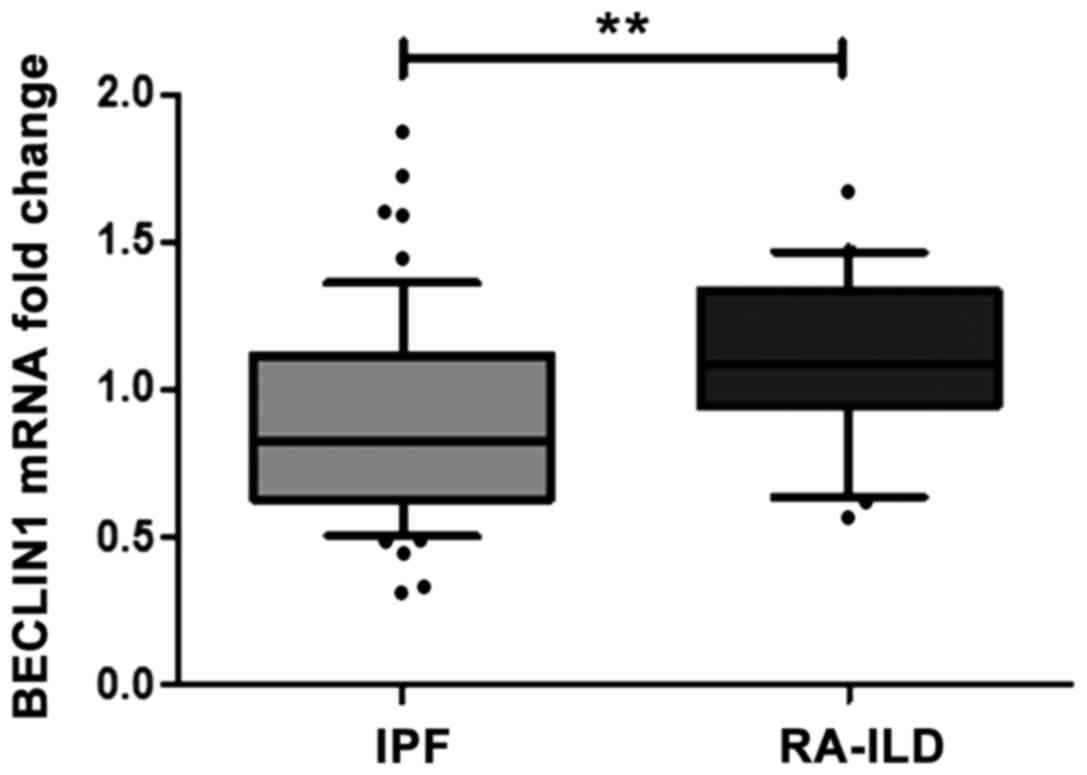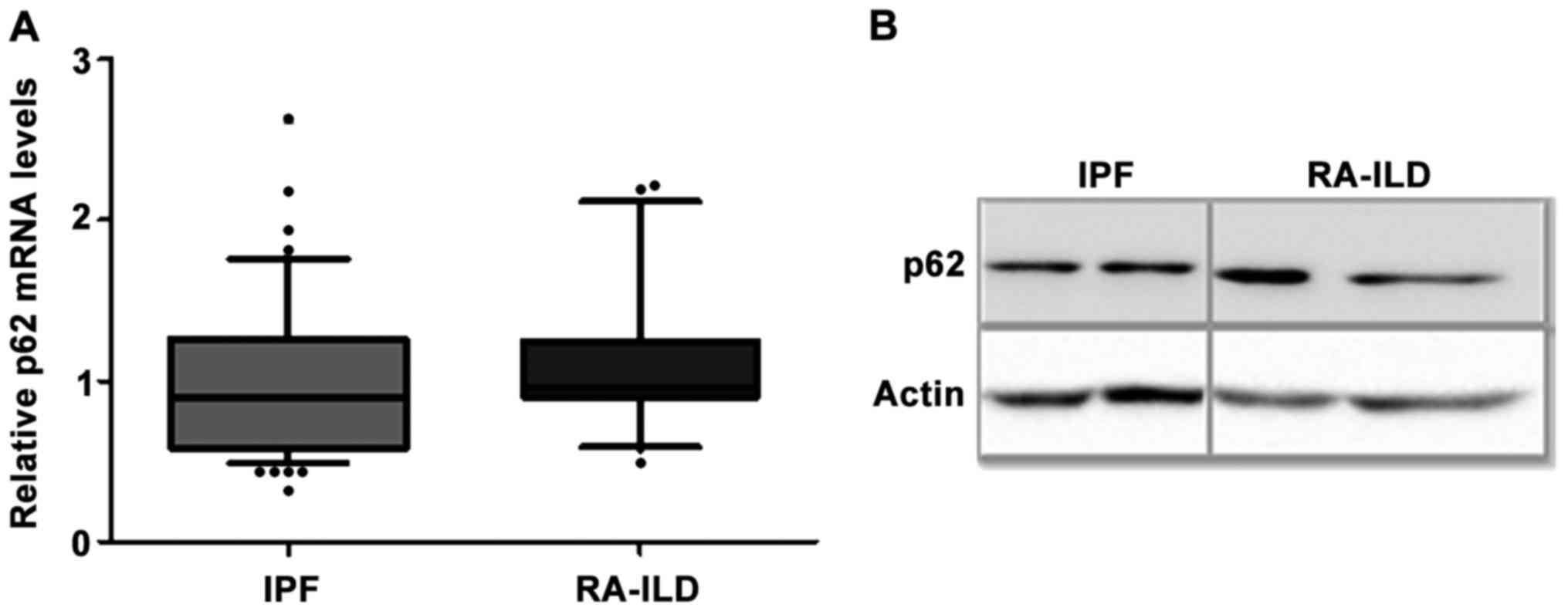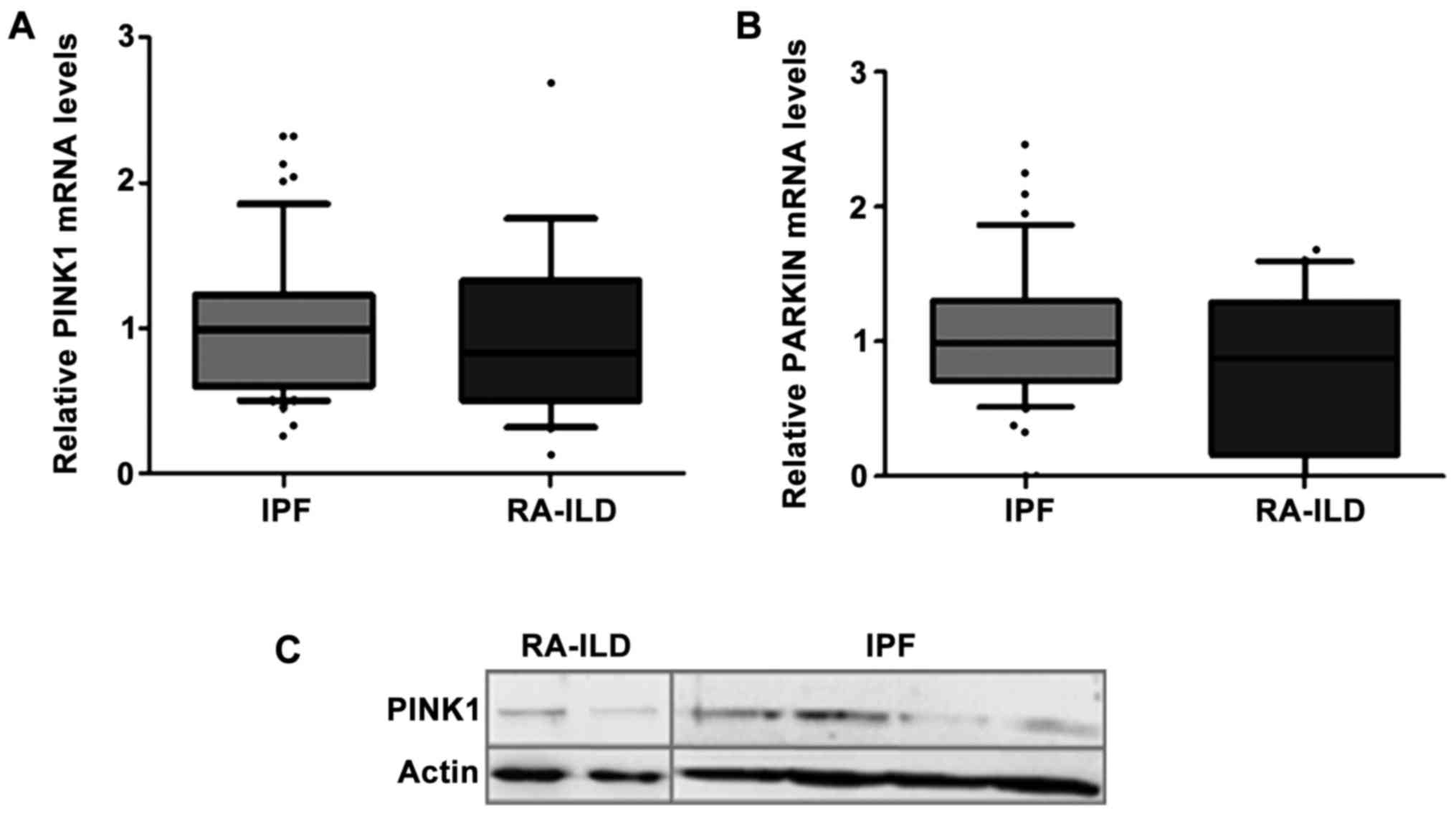|
1
|
Cuervo AM: Autophagy and aging: Keeping
that old broom working. Trends Genet. 24:604–612. 2008. View Article : Google Scholar : PubMed/NCBI
|
|
2
|
Deretic V, Saitoh T and Akira S: Autophagy
in infection, inflammation and immunity. Nat Rev Immunol.
13:722–737. 2013. View
Article : Google Scholar : PubMed/NCBI
|
|
3
|
Nakahira K, Pabon Porras MA and Choi AM:
Autophagy in pulmonary diseases. Am J Respir Crit Care Med.
194:1196–1207. 2016. View Article : Google Scholar : PubMed/NCBI
|
|
4
|
Hwang JW, Chung S, Sundar IK, Yao H,
Arunachalam G, McBurney MW and Rahman I: Cigarette smoke-induced
autophagy is regulated by SIRT1-PARP-1-dependent mechanism:
Implication in pathogenesis of COPD. Arch Biochem Biophys.
500:203–209. 2010. View Article : Google Scholar : PubMed/NCBI
|
|
5
|
Chen ZH, Kim HP, Sciurba FC, Lee SJ,
Feghali-Bostwick C, Stolz DB, Dhir R, Landreneau RJ, Schuchert MJ,
Yousem SA, et al: Egr-1 regulates autophagy in cigarette
smoke-induced chronic obstructive pulmonary disease. PLoS One.
3:e33162008. View Article : Google Scholar : PubMed/NCBI
|
|
6
|
Monick MM, Powers LS, Walters K, Lovan N,
Zhang M, Gerke A, Hansdottir S and Hunninghake GW: Identification
of an autophagy defect in smokers' alveolar macrophages. J Immunol.
185:5425–5435. 2010. View Article : Google Scholar : PubMed/NCBI
|
|
7
|
Wolters PJ, Collard HR and Jones KD:
Pathogenesis of idiopathic pulmonary fibrosis. Annu Rev Pathol.
9:157–179. 2014. View Article : Google Scholar : PubMed/NCBI
|
|
8
|
Johnson C, Giles JT, Bathon J, Lederer D,
Hoffman EA, Barr RG and Danoff SK: Smoking and Subclinical ILD in
RA versus the Multi-Ethnic Study of Atherosclerosis. PLoS One.
11:e01530242016. View Article : Google Scholar : PubMed/NCBI
|
|
9
|
Bernstein EJ, Barr RG, Austin JHM, Kawut
SM, Raghu G, Sell JL, Hoffman EA, Newell JD Jr, Watts JR Jr, Nath
PH, et al: Rheumatoid arthritis-associated autoantibodies and
subclinical interstitial lung disease: The Multi-Ethnic Study of
Atherosclerosis. Thorax. 71:1082–1090. 2016. View Article : Google Scholar : PubMed/NCBI
|
|
10
|
Solomon JJ, Chung JH, Cosgrove GP,
Demoruelle MK, Fernandez-Perez ER, Fischer A, Frankel SK, Hobbs SB,
Huie TJ, Ketzer J, et al: Predictors of mortality in rheumatoid
arthritis-associated interstitial lung disease. Eur Respir J.
47:588–596. 2016. View Article : Google Scholar : PubMed/NCBI
|
|
11
|
Luban S and Li ZG: Citrullinated peptide
and its relevance to rheumatoid arthritis: An update. Int J Rheum
Dis. 13:284–287. 2010. View Article : Google Scholar : PubMed/NCBI
|
|
12
|
Olson AL, Swigris JJ, Sprunger DB, Fischer
A, Fernandez-Perez ER, Solomon J, Murphy J, Cohen M, Raghu G and
Brown KK: Rheumatoid arthritis-interstitial lung disease-associated
mortality. Am J Respir Crit Care Med. 183:372–378. 2011. View Article : Google Scholar : PubMed/NCBI
|
|
13
|
Kim HP, Wang X, Chen ZH, Lee SJ, Huang MH,
Wang Y, Ryter SW and Choi AM: Autophagic proteins regulate
cigarette smoke-induced apoptosis: Protective role of heme
oxygenase-1. Autophagy. 4:887–895. 2008. View Article : Google Scholar : PubMed/NCBI
|
|
14
|
Cuervo AM, Bergamini E, Brunk UT, Dröge W,
Ffrench M and Terman A: Autophagy and aging: The importance of
maintaining ‘clean’ cells. Autophagy. 1:131–140. 2005. View Article : Google Scholar : PubMed/NCBI
|
|
15
|
Patel AS, Lin L, Geyer A, Haspel JA, An
CH, Cao J, Rosas IO and Morse D: Autophagy in idiopathic pulmonary
fibrosis. PLoS One. 7:e413942012. View Article : Google Scholar : PubMed/NCBI
|
|
16
|
Rangarajan S, Kurundkar A, Kurundkar D,
Bernard K, Sanders YY, Ding Q, Antony VB, Zhang J, Zmijewski J and
Thannickal VJ: Novel mechanisms for the antifibrotic action of
Nintedanib. Am J Respir Cell Mol Biol. 54:51–59. 2016. View Article : Google Scholar : PubMed/NCBI
|
|
17
|
Shin YJ, Han SH, Kim DS, Lee GH, Yoo WH,
Kang YM, Choi JY, Lee YC, Park SJ, Jeong SK, et al: Autophagy
induction and CHOP under-expression promotes survival of
fibroblasts from rheumatoid arthritis patients under endoplasmic
reticulum stress. Arthritis Res Ther. 12:R192010. View Article : Google Scholar : PubMed/NCBI
|
|
18
|
Ireland JM and Unanue ER: Autophagy in
antigen-presenting cells results in presentation of citrullinated
peptides to CD4 T cells. J Exp Med. 208:2625–2632. 2011. View Article : Google Scholar : PubMed/NCBI
|
|
19
|
Samara KD, Trachalaki A, Tsitoura E,
Koutsopoulos AV, Lagoudaki ED, Lasithiotaki I, Margaritopoulos G,
Pantelidis P, Bibaki E, Siafakas NM, et al: Upregulation of
citrullination pathway: From Autoimmune to Idiopathic Lung
Fibrosis. Respir Res. 18:2182017. View Article : Google Scholar : PubMed/NCBI
|
|
20
|
Selman M and Pardo A: Revealing the
pathogenic and aging-related mechanisms of the enigmatic idiopathic
pulmonary fibrosis. an integral model. Am J Respir Crit Care Med.
189:1161–1172. 2014. View Article : Google Scholar : PubMed/NCBI
|
|
21
|
Wynn TA and Vannella KM: Macrophages in
tissue repair, regeneration, and fibrosis. Immunity. 44:450–462.
2016. View Article : Google Scholar : PubMed/NCBI
|
|
22
|
Drakopanagiotakis F, Xifteri A, Tsiambas
E, Karameris A, Tsakanika K, Karagiannidis N, Mermigkis D,
Polychronopoulos V and Bouros D: Decreased apoptotic rate of
alveolar macrophages of patients with idiopathic pulmonary
fibrosis. Pulm Med. 2012:9817302012. View Article : Google Scholar : PubMed/NCBI
|
|
23
|
Larson-Casey JL, Deshane JS, Ryan AJ,
Thannickal VJ and Carter AB: Macrophage Akt1 kinase-mediated
mitophagy modulates apoptosis resistance and pulmonary fibrosis.
Immunity. 44:582–596. 2016. View Article : Google Scholar : PubMed/NCBI
|
|
24
|
Antoniou KM, Margaritopoulos G, Economidou
F and Siafakas NM: Pivotal clinical dilemmas in collagen vascular
diseases associated with interstitial lung involvement. Eur Respir
J. 33:882–896. 2009. View Article : Google Scholar : PubMed/NCBI
|
|
25
|
Lake F and Proudman S: Rheumatoid
arthritis and lung disease: From mechanisms to a practical
approach. Semin Respir Crit Care Med. 35:222–238. 2014. View Article : Google Scholar : PubMed/NCBI
|
|
26
|
Raghu G: Idiopathic pulmonary fibrosis:
Guidelines for diagnosis and clinical management have advanced from
consensus-based in 2000 to evidence-based in 2011. Eur Respir J.
37:743–746. 2011. View Article : Google Scholar : PubMed/NCBI
|
|
27
|
Arnett FC, Edworthy SM, Bloch DA, McShane
DJ, Fries JF, Cooper NS, Healey LA, Kaplan SR, Liang MH, Luthra HS,
et al: The American Rheumatism Association 1987 revised criteria
for the classification of rheumatoid arthritis. Arthritis Rheum.
31:315–324. 1988. View Article : Google Scholar : PubMed/NCBI
|
|
28
|
Barth S, Glick D and Macleod KF:
Autophagy: Assays and artifacts. J Pathol. 221:117–124. 2010.
View Article : Google Scholar : PubMed/NCBI
|
|
29
|
Margaritopoulos GA, Tsitoura E, Tzanakis
N, Spandidos DA, Siafakas NM, Sourvinos G and Antoniou KM:
Self-eating: Friend or foe? The emerging role of autophagy in
idiopathic pulmonary fibrosis. BioMed Res Int. 2013:4204972013.
View Article : Google Scholar : PubMed/NCBI
|
|
30
|
Mora AL, Bueno M and Rojas M: Mitochondria
in the spotlight of aging and idiopathic pulmonary fibrosis. J Clin
Invest. 127:405–414. 2017. View Article : Google Scholar : PubMed/NCBI
|
|
31
|
Bueno M, Lai YC, Romero Y, Brands J, St
Croix CM, Kamga C, Corey C, Herazo-Maya JD, Sembrat J, Lee JS, et
al: PINK1 deficiency impairs mitochondrial homeostasis and promotes
lung fibrosis. J Clin Invest. 125:521–538. 2015. View Article : Google Scholar : PubMed/NCBI
|
|
32
|
Kobayashi K, Araya J, Minagawa S, Hara H,
Saito N, Kadota T, Sato N, Yoshida M, Tsubouchi K, Kurita Y, et al:
Involvement of PARK2-mediated mitophagy in idiopathic pulmonary
fibrosis pathogenesis. J Immunol. 197:504–516. 2016. View Article : Google Scholar : PubMed/NCBI
|
|
33
|
Park JH, Kim DS, Park IN, Jang SJ,
Kitaichi M, Nicholson AG and Colby TV: Prognosis of fibrotic
interstitial pneumonia: Idiopathic versus collagen vascular
disease-related subtypes. Am J Respir Crit Care Med. 175:705–711.
2007. View Article : Google Scholar : PubMed/NCBI
|
|
34
|
Antoniou KM, Walsh SL, Hansell DM, Rubens
MR, Marten K, Tennant R, Hansel T, Desai SR, Siafakas NM, du Bois
RM, et al: Smoking-related emphysema is associated with idiopathic
pulmonary fibrosis and rheumatoid lung. Respirology. 18:1191–1196.
2013. View Article : Google Scholar : PubMed/NCBI
|
|
35
|
Juge PA, Borie R, Kannengiesser C, Gazal
S, Revy P, Wemeau-Stervinou L, Debray MP, Ottaviani S,
Marchand-Adam S, Nathan N, et al: FREX consortium: Shared genetic
predisposition in rheumatoid arthritis-interstitial lung disease
and familial pulmonary fibrosis. Eur Respir J. 49:492017.
View Article : Google Scholar
|
|
36
|
Araya J, Kojima J, Takasaka N, Ito S,
Fujii S, Hara H, Yanagisawa H, Kobayashi K, Tsurushige C, Kawaishi
M, et al: Insufficient autophagy in idiopathic pulmonary fibrosis.
Am J Physiol Lung Cell Mol Physiol. 304:L56–L69. 2013. View Article : Google Scholar : PubMed/NCBI
|
|
37
|
Kato M, Ospelt C, Gay RE, Gay S and Klein
K: Dual role of autophagy in stress-induced cell death in
rheumatoid arthritis synovial fibroblasts. Arthritis Rheumatol.
66:40–48. 2014. View Article : Google Scholar : PubMed/NCBI
|
|
38
|
Sorice M, Iannuccelli C, Manganelli V,
Capozzi A, Alessandri C, Lococo E, Garofalo T, Di Franco M,
Bombardieri M, Nerviani A, et al: Autophagy generates citrullinated
peptides in human synoviocytes: A possible trigger for
anti-citrullinated peptide antibodies. Rheumatology (Oxford).
55:1374–1385. 2016. View Article : Google Scholar : PubMed/NCBI
|
|
39
|
Lee J, Hong EC, Jeong H, Hwang JW, Kim H,
Bae EK, Ahn JK, Choi YL, Han J, Cha HS, et al: A novel histone
deacetylase 6-selective inhibitor suppresses synovial inflammation
and joint destruction in a collagen antibody-induced arthritis
mouse model. Int J Rheum Dis. 18:514–523. 2015. View Article : Google Scholar : PubMed/NCBI
|
|
40
|
Rockel JS and Kapoor M: Autophagy:
Controlling cell fate in rheumatic diseases. Nat Rev Rheumatol.
12:517–531. 2016. View Article : Google Scholar : PubMed/NCBI
|
|
41
|
Liang XH, Jackson S, Seaman M, Brown K,
Kempkes B, Hibshoosh H and Levine B: Induction of autophagy and
inhibition of tumorigenesis by beclin 1. Nature. 402:672–676. 1999.
View Article : Google Scholar : PubMed/NCBI
|
|
42
|
Semenza GL: Involvement of
hypoxia-inducible factor 1 in pulmonary pathophysiology. Chest. 128
Suppl 6:592S–594S. 2005. View Article : Google Scholar : PubMed/NCBI
|
|
43
|
Bellot G, Garcia-Medina R, Gounon P,
Chiche J, Roux D, Pouysségur J and Mazure NM: Hypoxia-induced
autophagy is mediated through hypoxia-inducible factor induction of
BNIP3 and BNIP3L via their BH3 domains. Mol Cell Biol.
29:2570–2581. 2009. View Article : Google Scholar : PubMed/NCBI
|
|
44
|
Zhang H, Bosch-Marce M, Shimoda LA, Tan
YS, Baek JH, Wesley JB, Gonzalez FJ and Semenza GL: Mitochondrial
autophagy is an HIF-1-dependent adaptive metabolic response to
hypoxia. J Biol Chem. 283:10892–10903. 2008. View Article : Google Scholar : PubMed/NCBI
|
|
45
|
Ricci A, Cherubini E, Scozzi D,
Pietrangeli V, Tabbì L, Raffa S, Leone L, Visco V, Torrisi MR,
Bruno P, et al: Decreased expression of autophagic beclin 1 protein
in idiopathic pulmonary fibrosis fibroblasts. J Cell Physiol.
228:1516–1524. 2013. View Article : Google Scholar : PubMed/NCBI
|
|
46
|
Sosulski ML, Gongora R, Danchuk S, Dong C,
Luo F and Sanchez CG: Deregulation of selective autophagy during
aging and pulmonary fibrosis: The role of TGFβ1. Aging Cell.
14:774–783. 2015. View Article : Google Scholar : PubMed/NCBI
|

















